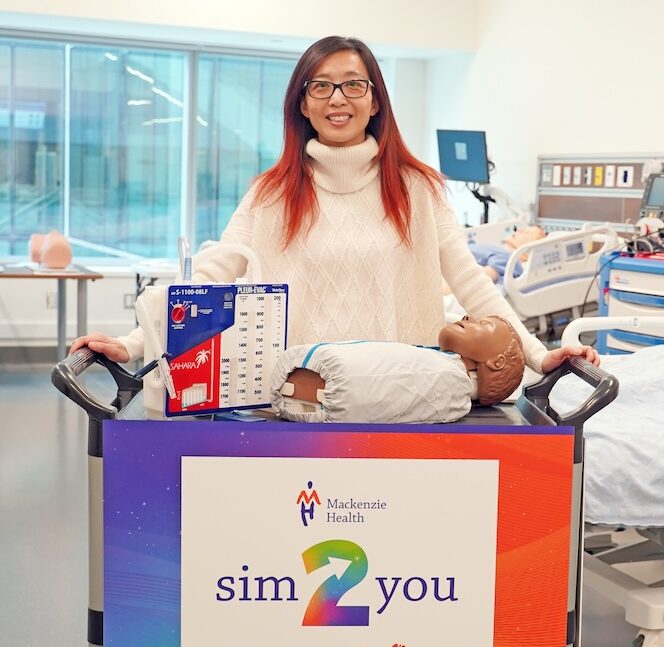
A 37-year-old man collapses on a golf course. He’s rushed by ambulance to the nearest hospital and needs to be intubated. He has no vital signs as the EMT continues CPR. The alert reaches the team at Cortellucci Vaughan Hospital’s Magna Emergency through triage, and within minutes, four nurses are in action.
One nurse takes the lead: “Pause compressions. Do we have a pulse? Resume compressions!”
As real as this scenario feels, it isn’t a real patient they’re working on. It’s a drill – a scenario meticulously orchestrated through Mackenzie Health’s Simulation Program.
The Simulation Program at Mackenzie Health has elevated the traditional learning experience. In addition to conducting mock scenarios and drills in the Giovanni and Anna De Gasperis/Eugene and Eva Kohn Learning Centre at Cortellucci Vaughan Hospital, the program also brings the training directly to frontline staff where they are. The team introduced the Sim2You roving cart, a mobile simulation unit, in January 2023 to offer a convenient and immersive learning experience right there, on their clinical units.
With the large numbers of new staff being hired to address health human resource challenges, new ways of teaching outside the traditional classroom setting have become necessary to train clinical staff quickly and
efficiently.
“Using the Sim2You roving cart, we’re not only ensuring that training is more accessible for our staff, we’re also enhancing how they can adapt to some of the real-life situations they may encounter in their day-to-day work caring for patients,” said Christina Scerbo, Simulation Program Lead. “Innovations like this along with our continued commitment to staff development are resulting in improved performance and better outcomes for our patients.”
The mobile simulation unit is offered across both Mackenzie Health hospitals, Mackenzie Richmond Hill Hospital and Cortellucci Vaughan Hospital, and at its patient care units at the Reactivation Care Centre. For hospitals without a fully outfitted simulation lab, a mobile simulation unit can be a cost-effective way to incorporate simulation into a training program.
In the scenario with the 37-year-old patient, CPR compressions are done on a manikin attached to an iPad that provides feedback on the technique in real time, offering an opportunity for nurses to make corrections and learn in the moment.
Mackenzie Health’s interdisciplinary team of health care professionals continually refine their skills, from electronic medical record updates to surgical best practices. Feedback from staff is taken into consideration when selecting the content for each month’s training – staff get to learn and brush up on what’s most topical and relevant to the work they do.
Another recent exercise brought the Sim2You roving cart to units to help staff improve rates of central line associated blood infection (CLABSI). In the exercise, a manikin’s arm is sprinkled with powder before a nurse begins the process of disinfecting the arm and inserting a central line. Once she’s done the job, a blue light is directed at the arm to identify where spots may have been missed and where there’s now a risk of a central line
infection.
Having staff regularly brushing up their skills and trained in best practice leads to positive results. Over the span of three years, Mackenzie Health was able to decrease its CLABSI rates by more than 40 per cent and is now well below the 2020 national benchmark rate of 4.08 per 1000-line days.
In simulation exercises, health care professionals replicate the challenges of real-life situations. As scenarios unfold, nurses are given a complex medical situation, challenging their skills and teamwork. They swiftly assess a simulated manikin and perform life-saving interventions.
In the simulation laboratories at Cortellucci Vaughan Hospital, the hum of medical equipment and urgent discussions creates an atmosphere of intensity and dedication. From cardiac arrest responses to newborn intubations, the labs offer a simulated hospital environment for safe practice. The control room, doubling as an observatory, provides clinicians with hands-on training before applying skills in live hospital settings.
“Positioning learning as our facility’s cornerstone advances life-saving skills and provides a secure environment for staff training,” says Deborah Lefave, Simulation Educator. “Our simulation labs immerse health care professionals in dynamic scenarios, fostering swift and co-ordinated actions. Prioritizing teamwork, communication and protocol adherence equips our teams with the resources and confidence needed for effective responses in real emergencies, elevating patient care and safety.”
As a simulation concludes in the Learning Centre at Cortellucci Vaughan Hospital, the team of dedicated nurses exchange nods of satisfaction. The stable manikin they were working on now represents the successful culmination of their collective efforts. Lefave smiles, noting each participant’s growth. Drills like this one highlight the transformative impact of preparation and innovation, promising a health care future led by expertise and unwavering commitment.
By Christina Cindric and Alysia Burdi
Christina Cindric and Alysia Burdi work in communications at Mackenzie Health.

